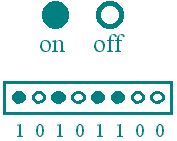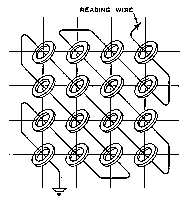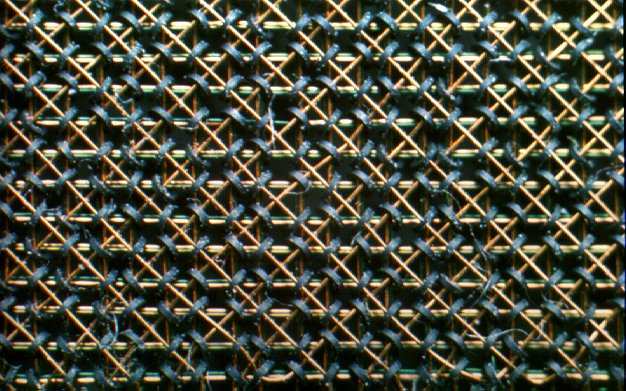What do bits
have to do with computers??
 Bits,
or light switches, if you wish, are how the computer stores information.
Bits,
or light switches, if you wish, are how the computer stores information.
Right. Light switches.
Controlled by little alien light switchers, right?
Basically,
yes.

 It
is how information is stored in RAM (Random Access Memory), the registers in the
Central Processing Unit (CPU), and secondary storage (hard drives, CD-ROMS,
etc). Both RAM and the CPU do contain little "light switches", and essentially
act just the same as the light switches we have discussed in the previous
tutorials. They are either 'on', or have electricty flowing through them, or
they are 'off ' or have no electricty flowing through them (Actually, they
always have electricity flowing through them, but the electricity is either high
or low voltage; still a binary condition).
It
is how information is stored in RAM (Random Access Memory), the registers in the
Central Processing Unit (CPU), and secondary storage (hard drives, CD-ROMS,
etc). Both RAM and the CPU do contain little "light switches", and essentially
act just the same as the light switches we have discussed in the previous
tutorials. They are either 'on', or have electricty flowing through them, or
they are 'off ' or have no electricty flowing through them (Actually, they
always have electricity flowing through them, but the electricity is either high
or low voltage; still a binary condition).
It might make a little
more sense if we go back in time to the first computers.

 The
main memory (RAM) for the first computers were magnetic cores.
A small ring, or core, originally about the size of a
'o' (the character 'o') on a printed page of paper, made of of ferrite (a ferromagnetic ceramic)
could be
magnetized in either of two opposite directions (clockwise or counterclockwise).
Therefore such a core can be used for storing a bit of information. For almost
15 years, 'core' was the most important memory device.
These cores were the 'light
switches' that were either 'on' or 'off'.
The
main memory (RAM) for the first computers were magnetic cores.
A small ring, or core, originally about the size of a
'o' (the character 'o') on a printed page of paper, made of of ferrite (a ferromagnetic ceramic)
could be
magnetized in either of two opposite directions (clockwise or counterclockwise).
Therefore such a core can be used for storing a bit of information. For almost
15 years, 'core' was the most important memory device.
These cores were the 'light
switches' that were either 'on' or 'off'.
Sorry about the 'alien light
switchers', but the voltage sent through RAM and the CPU were originally
controlled by Vacuum Tubes (Generation I), Transistors (Generator II) and later
by transistors embedded in silicon chips.
Therefore, we could say that a computer
is essentially a collection of light switches (bits).
That's it? Light switches?
Yes and no. Certainly,
there is much more: Busses to move the data, Logic gates, instructions, much
more. But at the core of it all are the "light switches" (bits).
The main difference
between what we we view as a light switch, and the messages it conveys, and a
bit is how quickly we change the information it represents. Computers use
electronic switches, as opposed to mechanical switches.
How quickly can we change the
information represented?
That's coming up next.
Some good additional references include:
-
How do Computer Clocks
work?
-
Binary Code:
The Bits and Bytes Game
- An
essay on bits, bytes
At this point in time, you should be
able to Answer the following questions:
- How
are bits, or light switches, the basis of computers?
It is how information
is stored in RAM (Random Access Memory) and in the registers in the Central
Processing Unit (CPU).
- How were these "light switches"
originally stored?
The
main memory (RAM) for the first computers were magnetic cores.
A small ring, or core, originally about the size of a
'o' (the character 'o') on a printed page of paper, made of of ferrite (a ferromagnetic ceramic)
could be magnetized in either of two opposite
directions (clockwise or counterclockwise).
- How was the voltage to these "light
switches" controlled?
The voltage sent through RAM and the CPU were originally controlled by
Vacuum Tubes (Generation I), Transistors (Generator II) and later by
transistors embedded in silicon chips.
- How are computer switches different
from "light switches"?
The main difference between what we we view as a light switch, and the
messages it conveys, and a bit is how quickly we change the information it
represents. Computers use electronic switches, as
opposed to mechanical switches.
- Bits form the basis of:
a. RAM Storage
b. Secondary Storage
c. CPU Storage
d. a and c
e. All of the above
Answer: e
- RAM originally consisted of:
a. Transistors
b. Magnetic Core
c. Vacuum Tubes
d. Integrated Circuits
e. All of the above
Answer: b
- The difference betwen a light switch
and an electronic switch is:
a. light switches are mechanical
b. electronic switches are slower
c. electronic switches rely on decibel regulation
d. a and c
e. All of the above
Answer: a
- The voltage sent to electronic
switches is now controlled by:
a. Transistors
b. Magnetic Core
c. Vacuum Tubes
d. Integrated Circuits
e. All of the above
Answer: d

This page was last updated on
05/23/05

 CIS3355:
Business Data Structures
CIS3355:
Business Data Structures